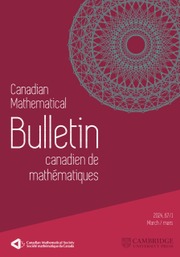Article contents
On the Borel-Cantelli Problem
Published online by Cambridge University Press: 20 November 2018
Extract
Let (Ω,  , P) be a probability space, and A 1, A 2… be a sequence of members of
, P) be a probability space, and A 1, A 2… be a sequence of members of  . The classical Borel-Cantelli problem is to determine the probability that infinitely many events A k occur. The classical results may be found in Feller [2, p. 188]; while related work may be found in Spitzer [3, p. 317], and Dawson and Sankoff [1]. The latter works are generalizations of the Borel-Cantelli lemmas, taken in different directions.
. The classical Borel-Cantelli problem is to determine the probability that infinitely many events A k occur. The classical results may be found in Feller [2, p. 188]; while related work may be found in Spitzer [3, p. 317], and Dawson and Sankoff [1]. The latter works are generalizations of the Borel-Cantelli lemmas, taken in different directions.
In this paper, necessary and sufficient conditions will be given for infinitely many events A k to occur, with probability 1. A lower bound for the probability that only finitely many A k occur, is developed. In addition, necessary and sufficient conditions that only finitely many A k occur, with probability 1, are given.
Information
- Type
- Research Article
- Information
- Copyright
- Copyright © Canadian Mathematical Society 1970
References
- 6
- Cited by

